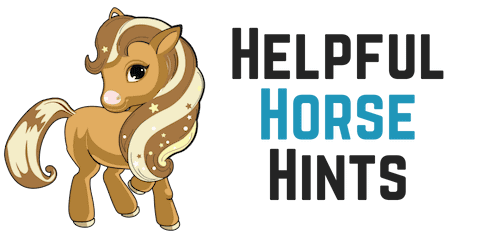While some horses, regardless of breed, may seem to be easy keepers, others struggle to maintain their weight. Whether you have a Thoroughbred, pony, or any other breed, weight management is critical for their health and well-being. Understanding how to help your horse achieve a healthy weight is essential, and it begins with a balanced nutrition plan.
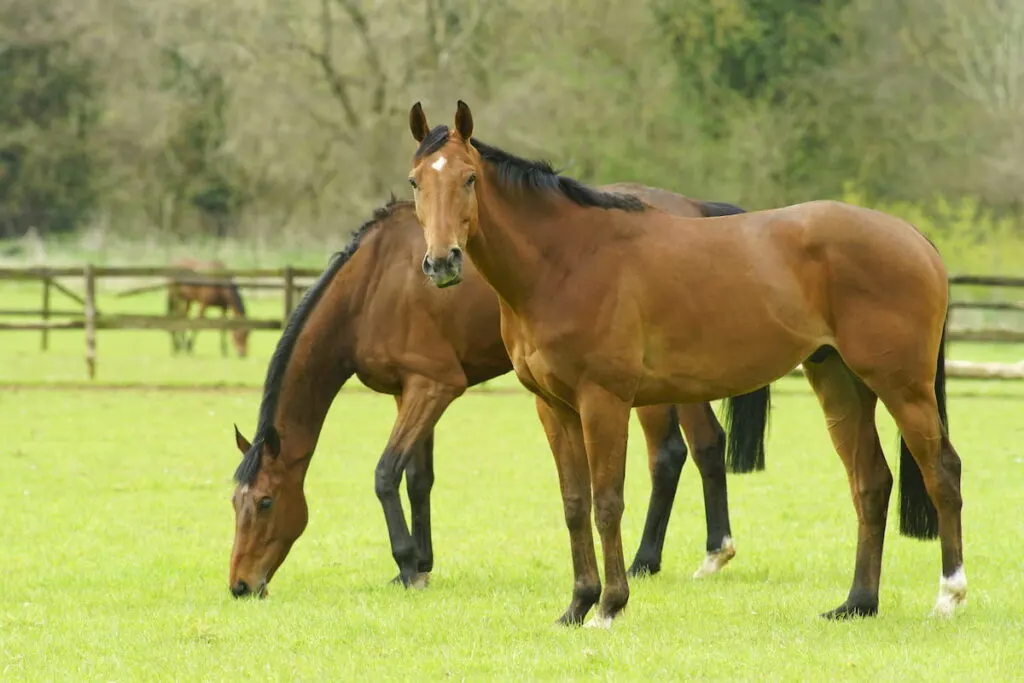
How to put weight on a horse? The first step is assessment: check teeth, and address worms; then feed the recommended amount, add grain gradually, use high-fiber supplements, and provide fresh water. Consult a vet for tailored advice.
In this article, we will delve into the various aspects of horse weight gain. From discussing caloric needs to exploring nutritional supplements, we have you covered. We will also discuss the importance of quality hay, deworming, and muscle development. Whether your horse is senior or young, we will provide the necessary tools and knowledge for healthy weight gain.
Table of Contents
Key Takeaways:
The main strategies for keeping a healthy weight on your horse include proper veterinary care, adjusting the horse’s diet, and providing high-calorie supplements.
| # | Strategy | Description |
|---|---|---|
| 1 | Veterinary Care | Regular health checks |
| 2 | Dental Health | Good dental maintenance |
| 3 | Deworming | Regular deworming program |
| 4 | Feeding Frequency | Increase feeding times |
| 5 | Forage Quality | High-quality hay/pasture |
| 6 | High-Fat Diet | Incorporate high-fat feeds |
| 7 | Caloric Density | Feeds with higher calories |
| 8 | Protein Content | Adequate protein in diet |
| 9 | Supplements | Weight-gain/calorie-rich supplements |
| 10 | Hydration | Consistent water access |
| 11 | Feeding Environment | Stress-free feeding area |
| 12 | Weight Monitoring | Regular weight checks |
| 13 | Exercise | Balance exercise with dietary needs |
First Step: Body Condition & Assessment
Ensuring your horse maintains a healthy weight is essential for its well-being. One vital aspect is body condition scoring, a systematic method of assessing a horse’s overall condition. It helps determine if a horse is underweight or overweight, making it a critical tool for equine health. (Source)
Regular dental check-ups are crucial for addressing teeth-related issues that can affect chewing and digestion. Equine nutrition plays a crucial role in maintaining an ideal body condition score for all horse breeds, from ponies to older horses. Monitor for worm infestations and consult a vet for deworming to prevent weight loss and malnutrition.
If weight issues persist, a vet can identify diseases like insulin resistance, anemia, or gastric ulcers that affect the horse. These measures help your horse stay healthy and achieve the ideal body condition score.
1. Get Your Horse’s Teeth Checked
To ensure your horse’s well-being, dental health is essential. Regular check-ups with an equine veterinarian are crucial.
Collaborate on a tailored feeding plan, considering the needs of different horse breeds. Proper horse nutrition is the key to maintaining a healthy weight. Research shows that dental care and a personalized weight gain plan are essential. Consult a vet if you observe signs, as they can eliminate problems related to health conditions.
I recommend calling your vet if you notice these signs:
- Dropped Feed: If your horse frequently drops feed while eating, it may indicate dental problems.
- Slow Eating: If your horse suddenly starts eating more slowly than usual, it could be a sign of discomfort.
- Excessive Salivation: An increase in salivation, especially during or after eating, can be a sign of dental issues.
- Quidding: This refers to the habit of spitting out partially chewed food, indicating difficulty in chewing properly.
A bad tooth or an infection could also be causing the problem and may need medical attention. (source) Work with your veterinarian to find the best food for a horse that is missing a lot of teeth. (source)
Learn more about equine dental care and what every horse owner should know in this informative article from AAEP
2. Have a Vet Check Your Horse for Worms
A significant worm infestation in horses can lead to malnutrition. It’s important to note that, regardless of the feed given, a horse plagued by parasites may struggle to gain weight.
With the right plan and the best wormer, you can help your horse ward off parasites and potentially achieve weight gain. It’s essential to take time to find a solution, especially if you’re not sure which deworming strategy to use. Frequent deworming is the usual approach to eliminate these issues and ensure your horse’s health and well-being.
Signs of infestation could be:
- Skin Issues: Skin problems in your horse, such as irritation, rashes, or unusual sores, can be indicative of a worm infestation.
- Hair Loss: Excessive hair loss or patchy fur can be a visible sign that your horse may have a worm problem.
- Poor Coat Quality: If your horse’s coat appears dull, lacks shine, or feels rough to the touch, it could be related to a worm infestation affecting their overall health.
- Lethargy: An unusually tired or lethargic horse may be showing signs of discomfort or distress, potentially linked to worm-related issues.
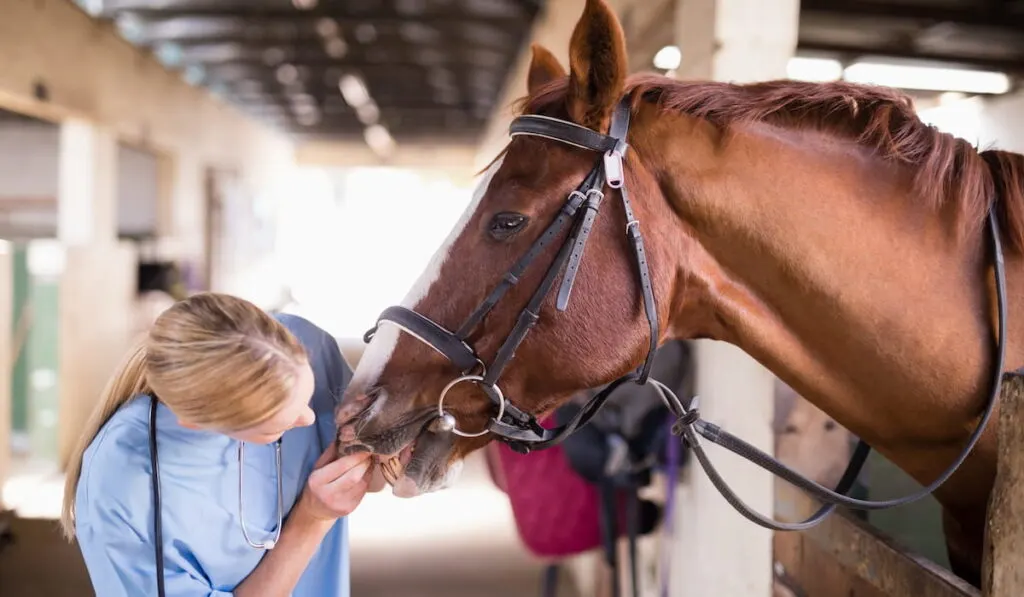
With the right plan and the best wormer, you can help your horse ward off parasites and hopefully gain weight as a result. (source)
3. Undiagnosed Diseases – One More Reason For Weight Loss
Undiagnosed diseases like insulin resistance, anemia, kidney disease, and Cushing’s disease can cause weight loss in horses. Additionally, chronic infections and gastric ulcers can lead to weight loss. It’s important to thoroughly assess all possible factors, including the digestive system
If your vet discovers an illness, you can work with him or her to establish a treatment plan as soon as possible. (source)
Horse Weight: Strategies for Healthy Weight Gain
Let’s look at effective ways to keep your horse healthy and at a good weight. From adjusting their feeding regimen based on activity level to adding high-fat horse feed and supplements, these tips can benefit all horses, ensuring they receive the nutrition they need to thrive.
3. Make Sure You Are Feeding the Recommended Amounts
Many horse owners who have a ‘hard keeper’ often find out that they are not feeding the recommended amount for their horse.
Buy a food scale to measure your horse’s daily feed and hay. The product bag usually lists the suggested feeding amounts for grain.
For hay, horses should eat around 2 percent of their weight in forage each day. They will need more to gain weight.
Sometimes, just feeding the correct recommended amount of feed to your horse is the answer to your problem.
4. Adjust Your Feeding Regimen Based on Activity Level
Equines’ dietary needs should align with their activity level, and adjustments may be necessary.
For example, horses with higher activity levels, such as regular exercise or competition, often need increased calorie intake to replenish expended energy. This adjustment in their diet, which may include considerations like fats and protein, ensures that they maintain a healthy weight without losing condition.
5. Feed Your Horse Extra Forage
If your horse is already consuming the recommended amount of forage, consider supplementing their diet with additional hay or access to richer pasture.
Gradually increasing the hay portion of your horse’s daily diet to approximately 2.5 percent of their target weight can provide added nutrition. Opt for free-choice hay or high-quality grass for the best results, including high-quality hay for their overall diet.
Consider reviewing this informative article to identify the optimal hay choices for the well-being of your equine companion.
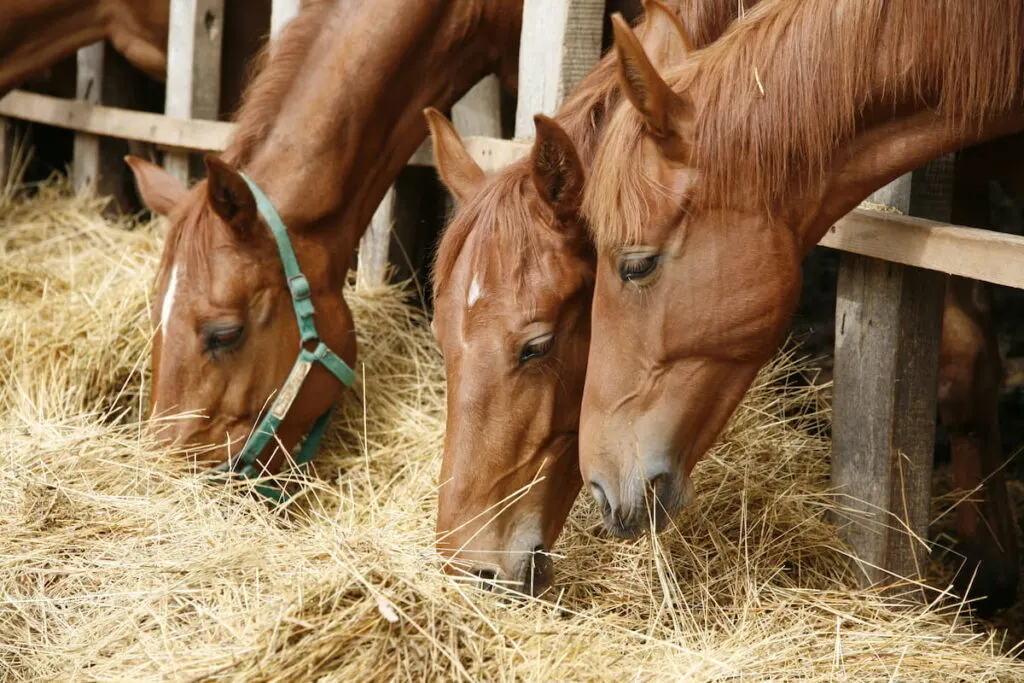
If possible, allow your horse access to grass or hay or a combination of both throughout the day. If this is not possible, consider adding more hay to your horse’s regular meals. (source)
6. Add Grain to Your Horse’s Diet
If you do not already feed grain to your horse, consider adding it to your horse’s diet to help it gain weight. Grain should be introduced slowly and forage should still remain the bulk of their diet.
Grain is a great high-calorie option to help a thin horse or an active working horse gain weight when needed. It can be fed at regular intervals with forage throughout the day to avoid gastric upset.
Follow the instructions on the back of the bag to help determine the amount your horse will need each day. (source)
7. Add High-Calorie Supplements to Your Horse’s Diet
Try adding high-fiber supplemental foods such as beet pulp or soy hulls. High-fiber foods, such as wheat bran and alfalfa pellets, when fed in moderation, can help supplement poor forage qualities.
High-starch supplement foods such as processed corn or oats can help increase the energy in a horse’s diet. Whole corn is not recommended because it is harder for horses to digest. Supplemental fat sources can also be added to your horse’s diet to help them gain weight more quickly.
Rice bran, corn oil, and linseed are all great sources of fat, and therefore energy, for Thoroughbred horses.
Work with your veterinarian to find the best supplemental food options for your specific Thoroughbred. (source)
8. Add Vitamin Supplements
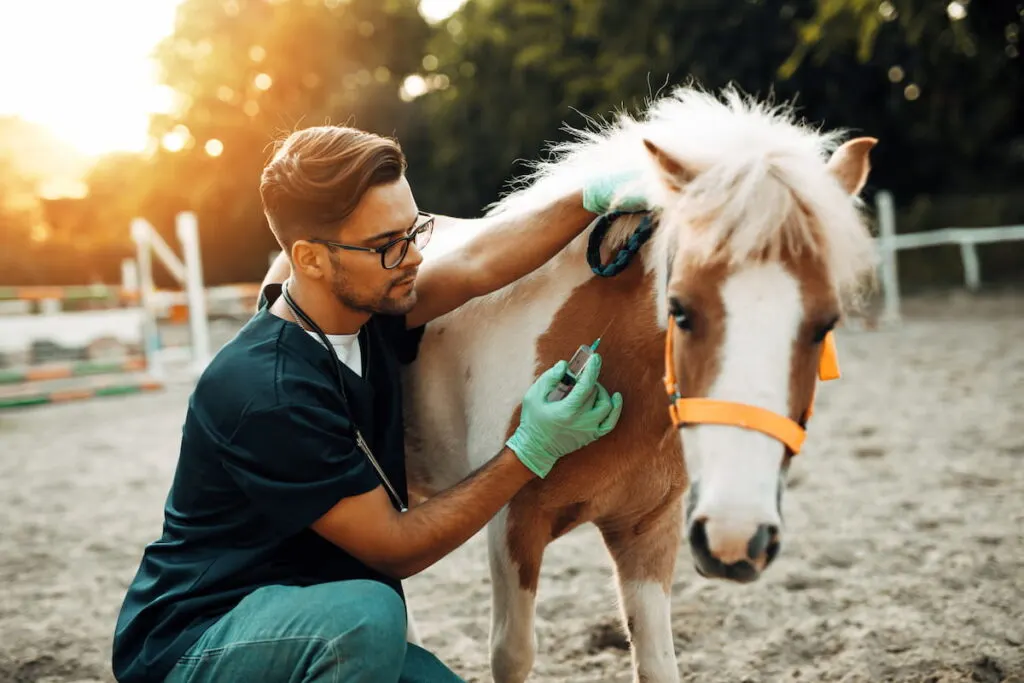
Vitamin B helps horses extract more calories from their food. It promotes digestive health and allows horses to absorb more nutrients from their food.
Vitamin B is also known to improve a horse’s appetite.
9. Increase the Number of Feedings
If you feed your horse twice a day, consider feeding him or her three times a day instead.
By increasing the number of feedings, you will increase the horse’s daily caloric intake.
This may help to add weight to your horse if too few calories are causing the lack of weight gain. Keep meals spaced throughout the day to give your horse time to digest its food properly.
10. Feed Separately from the Rest of the Herd
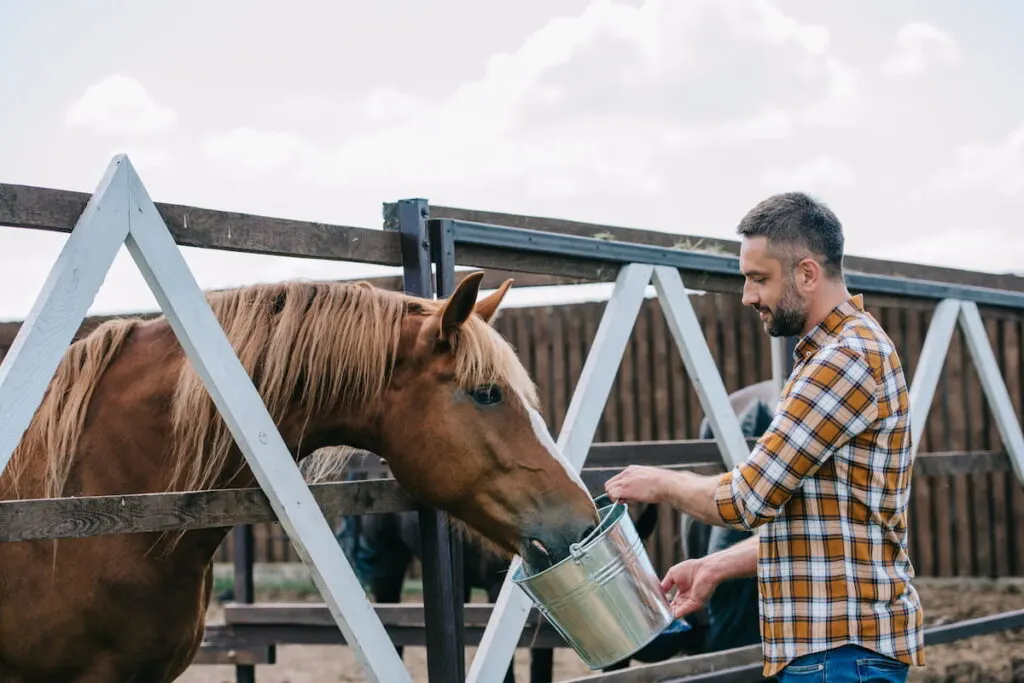
If you have multiple horses in the same enclosure, a natural hierarchy will be established within the herd. This can often lead to weaker horses not getting a turn at the hay bin or food trough.
Watch the social dynamic if you suspect this is the case and see if your hard-keeper horse is just not getting a chance to eat.
You can separate the horses at feeding time or, if that is not an option, you can try incorporating multiple feeders spaced apart from one another.
This may give your horse a better chance at getting his or her fair share of hay or grain. (source)
12. Adjust to Environmental Changes
Horses may experience challenges in extreme weather conditions, expending energy to stay cool in the heat and keep warm in the cold. Ensure that your horse has suitable shelter during harsh weather, whether it’s scorching hot or freezing cold. Consider using blankets in colder months to help them stay warm and conserve energy.
Provide adequate shelter for your horse during harsh weather, including hot sunny days and cold winter nights. Use blankets in the winter to help them stay warm and expend less energy.
13. Provide Plenty of Water
Horses need a constant supply of water to avoid becoming dehydrated. Dehydration can cause a lack of appetite and prevent a horse from eating its normal food, which can hinder weight gain. Make sure your horse has fresh water, especially during the winter when water can easily freeze.
If the horse regularly runs out of water, consider an extra bucket, container, or an automatic waterer. Running out of water daily is a signal they need a more constant supply. (source)
How to Monitor Your Horse’s Weight Gain
If you do not own a large animal scale, then you will need to use other methods to track your horse’s weight progress. Luckily, there are a few tricks you can use to easily monitor your horse’s weight gain.
1. Use a Measuring Tape
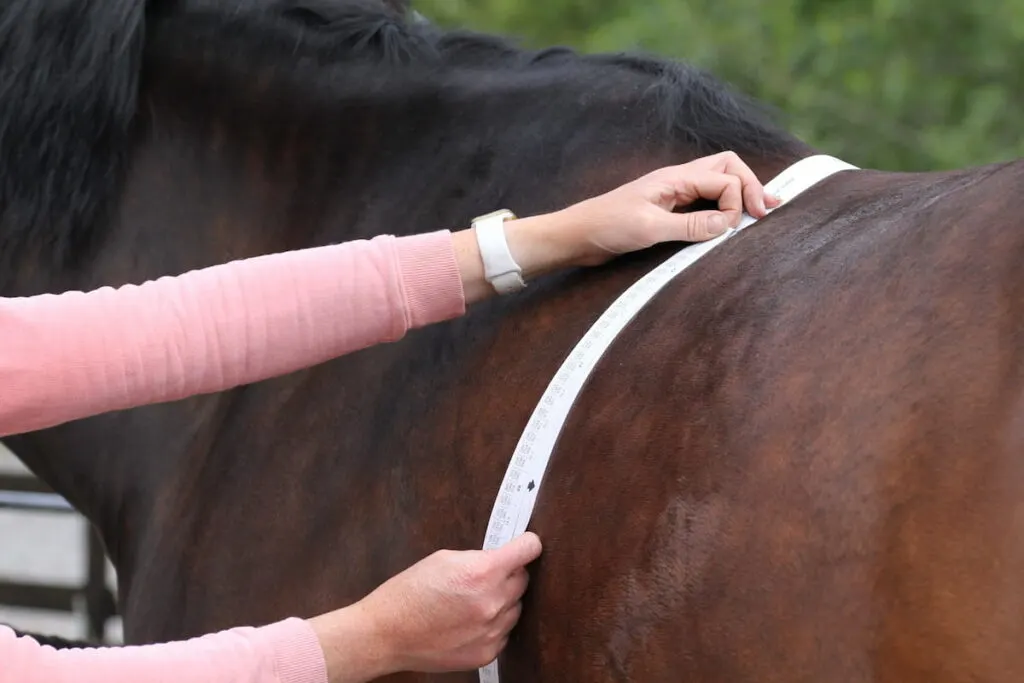
You can use a soft measuring tape (like this one ), preferably made for horses, to measure your horse’s size.
Measure the girth area at the beginning of your endeavor and periodically to track any changes. You are looking for the inches to increase as the horse gains weight.
2. Use a Chart or Journal to Track Progress
Write down the horse’s progress on a chart or in a journal so that you can really see the changes. This is good not only for your own memory but also gives you a record to show your veterinarian.
3. Take Pictures
It is difficult to see positive changes in your horse’s weight when you see him or her each day. Take a picture now to establish a baseline visual reminder of where your horse started. This will help you compare your horse’s progress visually, which helps you really see the positive changes.
For more information about measuring your horse’s weight, check out this post: 11 Ways to Measure a Horse’s Weight.
Frequently Asked Questions (FAQ):
How to Put Weight On a Senior Horse?
To put weight on a senior horse, start with a veterinary check-up to rule out underlying health issues, such as dental problems or diseases, which can affect weight gain. Once health concerns are addressed, focus on the diet.
Senior horses often require higher calorie intake, so offer high-quality forage like hay, which is easy to chew and digest. Including senior-specific feeds in their diet is beneficial as these are usually higher in fiber and fat but lower in sugar, providing necessary calories without causing digestive issues. Supplements designed for senior horses can also be added to ensure they receive all essential vitamins and minerals.
Read a full article on Tips for Putting Weight on Senior Horses!
How to Put Weight on a Laminitic Horse?
To safely put weight on a laminitic horse, it’s crucial to work closely with a veterinarian. The diet should be low in starch and sugar, focusing on high-fiber, low-carb forages like beet pulp, and balanced with appropriate vitamins and minerals.
Avoid lush grasses and grains that can worsen laminitis. Small, frequent meals help maintain gut health and prevent overloading the digestive system. It’s also important to provide regular, gentle exercise as tolerated to improve circulation in the hooves.
Careful monitoring and gradual dietary changes are key to ensuring the horse gains weight without exacerbating its laminitic condition.
Putting Weight on a Thoroughbred – Are There Specific Strategies?
To put weight on a Thoroughbred, provide high-quality forage and calorie-dense feeds like those with added fats. Opt for small, frequent meals rather than large ones for better digestion.
Ensure the diet is rich in protein and essential nutrients, and tailor the feeding plan to the horse’s specific needs with the help of a veterinarian or equine nutritionist. Regular, appropriate exercise and stress reduction are also important for healthy weight gain.
